Mertensia virginica
Gentlemen’s breeches or old ladies’ bonnets. Wait, are we talking about old fashioned clothing on a gardening website?
Eastern bluebell, Virginia cowslip, or Roanoke bells. Phew, it is a plant. Exactly what you came to learn about, right?
Don’t worry, we’ve covered the basics of everything you could ever want or need to know about how to grow, propagate, and care for the shade loving, blue bloomed North American native also known as blue and pink ladies, smooth lungwort, or chiming bells…
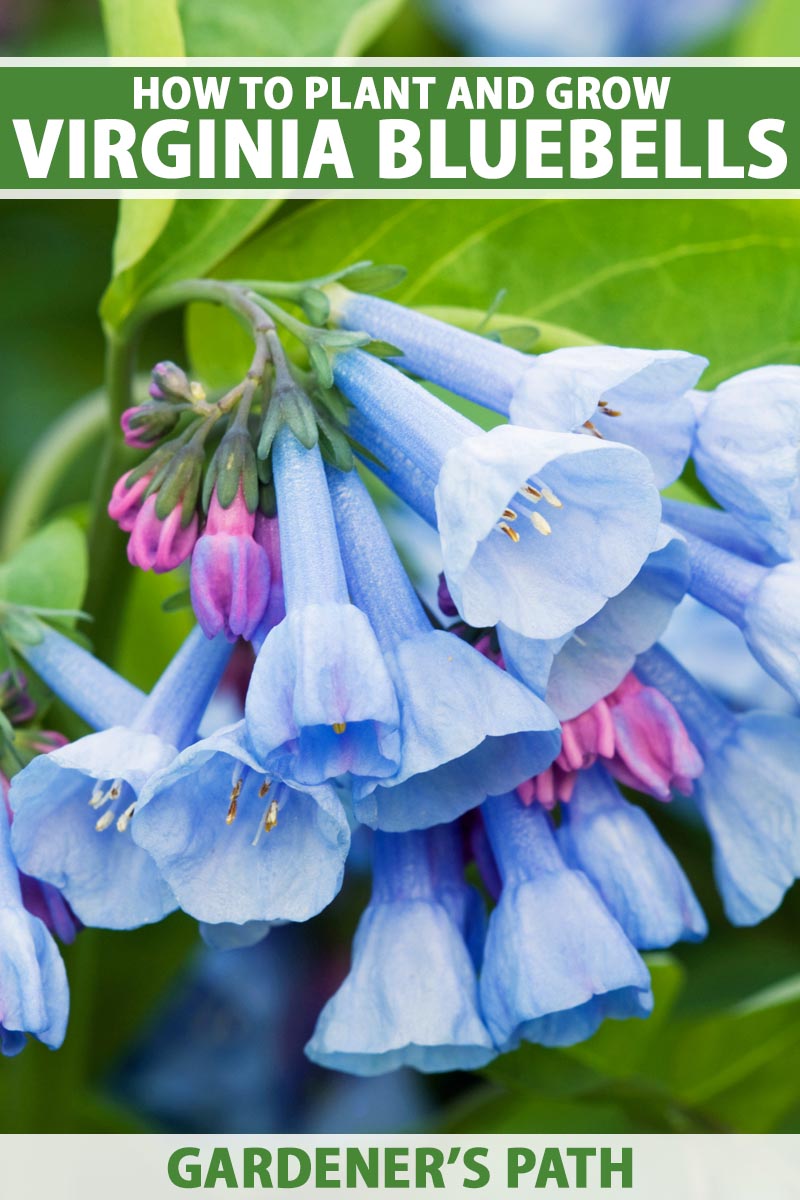
We link to vendors to help you find relevant products. If you buy from one of our links, we may earn a commission.
The common names go on and on, but whatever you choose to call M. virginica, it’s time to dig in!
Here’s what I’ll cover:
What You’ll Learn
Cultivation and History
Call it what you want, the most often agreed upon common name is Virginia bluebell, and it is an eastern North American native member of the borage, Boraginaceae, family.
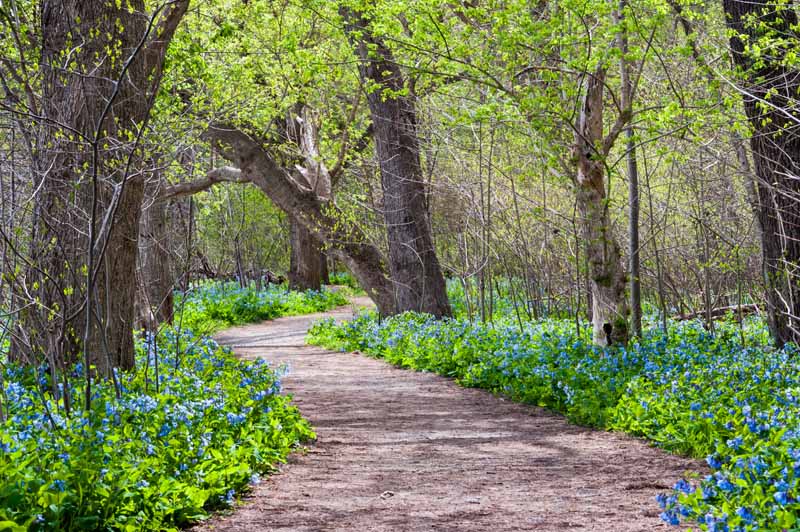
But just in case figuring out the best colloquial name for Mertensia virginica wasn’t confusing enough, the genus wasn’t always named Mertensia either.
Linnaeus, the father of modern taxonomy, called it Pulmonaria after a related European genus.
Later, botanist Albrecht Roth realized it was too different to be a true Pulmonaria, and renamed it Mertensia after German botanist Franz Carl Mertens.
Mertensia also happens to be the genus name of a group of jellyfish, which Mertens’ son Karl Heinrich Mertens studied.
So Mertensia is both something found in the woods and plains of eastern North America, and something you can find in the ocean!
Virginia bluebell was used by the Cherokee people to treat pertussis, tuberculosis, and other respiratory ailments, giving it yet another common name: oysterleaf lungwort. The Iroquois used the roots to treat venereal diseases.
That’s it, no more name calling. Despite all the nomenclature confusion, it really is a simple, striking plant. The blue-green leaves, bright pink buds, and blue flowers have made it a beloved native.
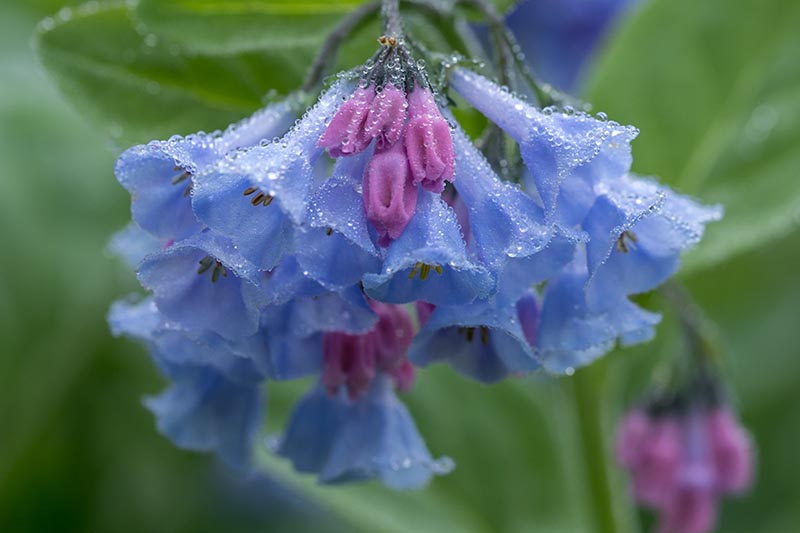
The bud color is created by anthocyanins, pigments that are also responsible for the vibrant color of blueberries, for example.
Anthocyanins are sensitive to pH changes, exhibiting a pink or red color at a lower and more acidic pH, and purple around neutral.

As it prepares to welcome pollinators, the plant increases the pH of its flowers, and the blossoms turn a shade of blue.
Virginia bluebells are pollinated by female bumblebees and other long-tongued bees, as well as some types of butterflies and moths.
Virginia Bluebell Plant Propagation
M. virginica can be propagated from seed or by division. Alternatively you can purchase existing plants or bare roots from your local nursery or online.
From Seed
The seeds ripen in the early summer before the plant goes dormant. Each wrinkled nutlet contains four seeds that you can collect, or you can purchase seeds online.
Seeds can be a little uncooperative and slow to germinate, and seedlings may take several years to finally bloom. Have patience!
They require a period of moist, cold stratification to break dormancy. You can achieve this the easy way by sowing the seeds outdoors in the late fall, or by allowing your plants to self seed and spread in natural patterns.
Lightly work the soil before planting, and amend poor soil with compost. Moisten the planting area, and sow seeds on the surface.
You can also refrigerate collected or purchased seeds to cold stratify them. Mix equal parts dampened sand and vermiculite or another type of sterile soilless medium, and fill a tray.
Sow the seeds and cover with plastic. Store in a 33-38°F fridge or other protected space for 60 days.
In the spring, move the tray outdoors or to a 70°F space indoors. The seeds may take a month or two to germinate. Keep the medium moist.
Transplant the strongest seedlings to individual pots filled with a rich, well draining soilless medium. Set them outdoors in a cool, shady area.
Keep the soil moist and allow the plants to develop over the season before transplanting into the garden in the fall.
By Division
If you are aiming for a mass planting of bluebells, dividing existing plants manually might be unnecessary.
In general, they prefer to be left undisturbed, and will spread and form beautiful carpets naturally. However, you can divide the plants when the foliage is dying back in the summer or in early fall if you wish.
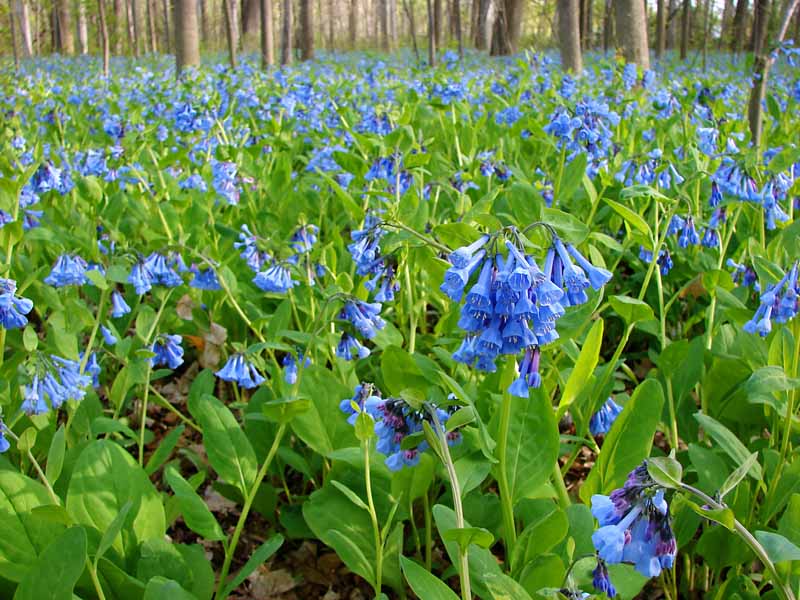
Carefully remove a mature plant from the ground by digging with a garden fork about six inches from the crown, taking extra care to protect the taproot during removal.
Cut the rhizomes apart and make sure each rhizome division has its own node. Let the rhizome divisions dry out in a cool dark place for a few days before planting.
Transplanting
Plant purchased or propagated plants and bare roots in the early spring or fall. If you plant them in the spring, they will go dormant in the summer without flowering, and will flower the following spring.
If you plant them in the fall, they will have time to become established before the arrival of winter weather and will flower the following spring.

Prepare poor soil by amending the site with compost. Rich loamy soils do not need amending. Transplants may be positioned 10 to 18 inches apart.
Water plants well before transplanting. Dig a hole two to three times larger than the root ball, and make sure the crown is placed level with the soil, not too deep. Backfill with loose soil and water in gently.
How to Grow Virginia Bluebell Flowers
Virginia bluebells are hardy in Zones 3-8 and will bloom for three weeks in March and April.
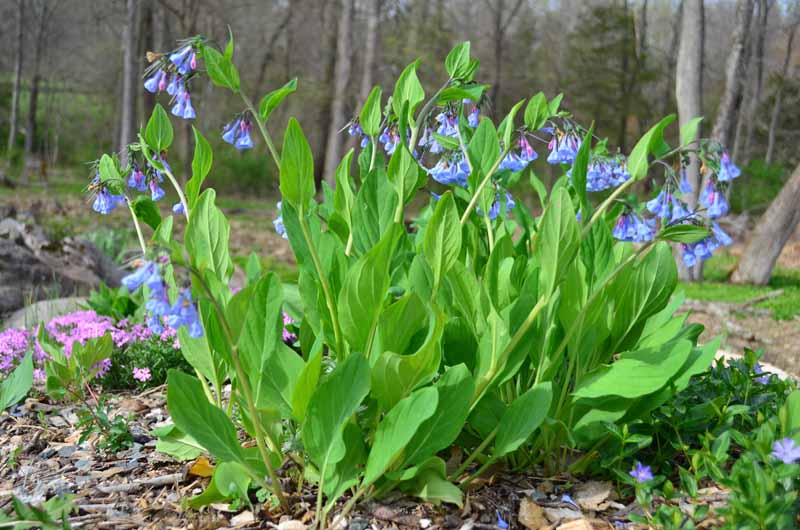
The foliage emerges in the early spring with an attractive deep purple color, slowly changing to blue-green as the leaves grow.
The flower buds are a lovely fuchsia color, and the flowers have a pinkish hue when they first bloom, transitioning to the blue color bluebells are famous for later.
Virginia bluebells do well in part to full shade and in rich, neutral, well draining, moist, loamy soil. They naturally occur in woods and river floodplains, so mimic these habitats for the happiest plants!
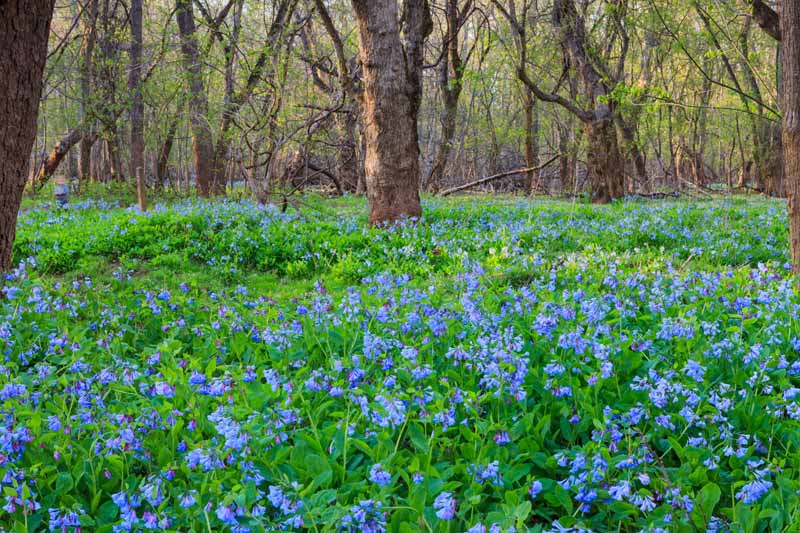
They will do fine in average soils as long as they are kept moist. Amend poor soil before planting with compost, and keep the soil rich by adding a layer of leaf mulch in the fall. Fertilizer is unnecessary.
Water regularly to keep the soil moist throughout the spring, reducing irrigation slightly once the plants are in flower, and ceasing to provide supplementary water when the plants go dormant in early summer.
Check soil moisture to two inches before watering.
Growing Tips
- Plant in part to full shade
- Plant in rich soils or amend poor soils with compost
- Keep the soil moist but avoid overwatering
Pruning and Maintenance
You will need to deadhead if you don’t want your plants to self seed.
If desired, cut the dead foliage back to tidy up your garden. Alternatively, plant with ferns, hostas, or hellebores, which will mask the dying and dead foliage of the bluebells as they grow.
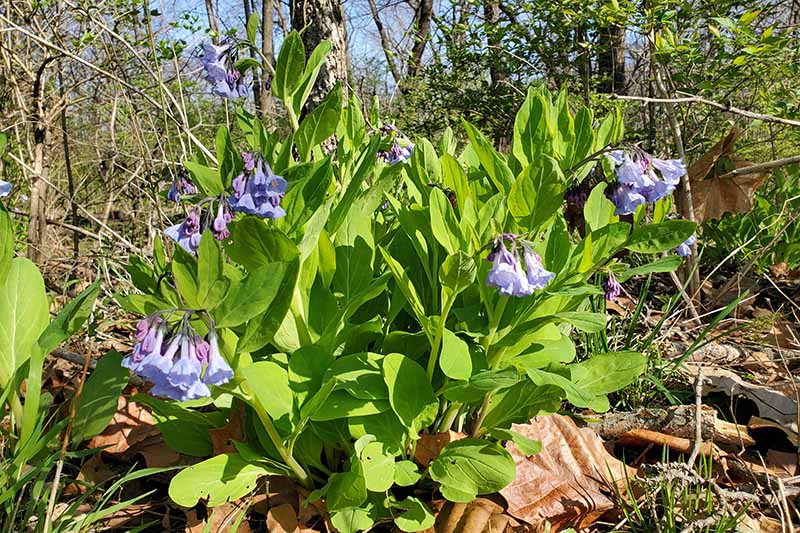
Apply a layer of leaf mulch in the fall, mimicking the leaf fall in the deciduous forests of some of its favorite habitats.
These leaves will enrich the soil and help to retain soil moisture in the following year.
Where to Buy Virginia Bluebell Bulbs
If you don’t have a gardener friend you can obtain seeds or divisions from, your local plant nursery might carry plants. It’s worth a look, and is a good excuse to visit.
If not, you can find seeds, bare root stock, and plants online.
Pick up packs of three bulbs from at Nature Hills Nursery.
Managing Pests and Disease
Virginia bluebells are deer and rabbit resistant. Besides attracting a variety of the beneficial pollinators such as bumblebees, hummingbird moths, and butterflies, they are usually unaffected by pests and diseases as well.
Their early start and short season helps them avoid pest and disease problems.
One issue that can crop up in very wet conditions is root rot. To prevent this fungal disease, plant in a well-draining spot and avoid watering during rainy periods.
Make sure to check the soil moisture in advance to avoid overwatering.
Best Uses for Virginia Bluebell Flowers
Because they love the shade, Virginia bluebells are a welcome plant for the gardeners out there that have shady spaces to spruce up.
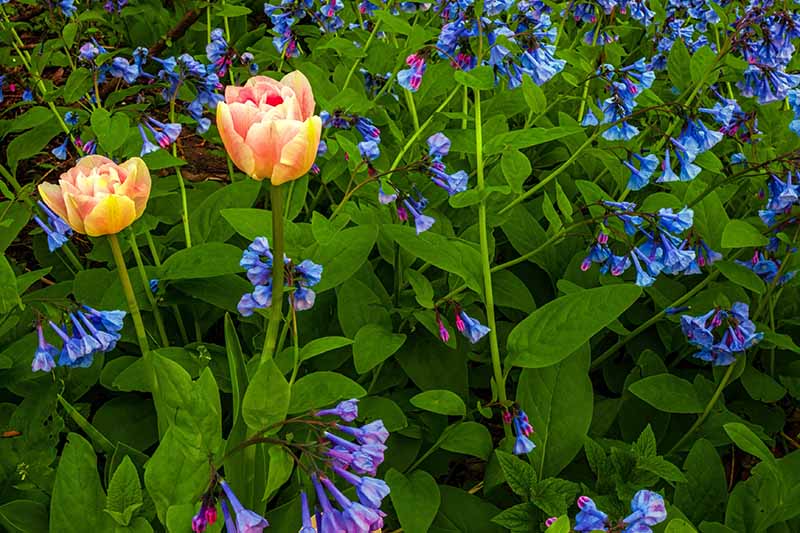
Create mass plantings under trees and in shady woodlands.
Add them to wildflower gardens or native gardens, spring bulb beds, and mixed plantings and borders with leafy spring and summer plants.
Quick Reference Growing Guide
| Plant Type: | Flowering herbaceous perennial | Flower / Foliage Color: | Pink buds, blue flowers/green |
| Native to: | Eastern North America | Maintenance: | Low |
| Hardiness (USDA Zone): | 3-8 | Tolerance: | Deer, rabbits |
| Bloom Time: | March-April | Soil Type: | Loam |
| Exposure: | Part to full shade | Soil pH: | 6.5-7.5 |
| Spacing: | 10-18 inches | Soil Drainage: | Well-draining |
| Planting Depth: | Surface (seeds), depth of root ball (transplants) | Companion Planting: | Ferns, hellebores, hostas, tulips, other spring bulbs |
| Height: | 18-24 inches | Uses: | Bulb beds, borders, naturalized areas, woodland plantings |
| Spread: | 12-18 inches | Family: | Boraginaceae |
| Water Needs: | Medium to high | Genus: | Mertensia |
| Common Disease: | Root rot | Species: | Virginica |
My Name is Bluebell… Virginia Bluebell
M. virginica is pretty easygoing. It doesn’t care what you call it, as long as you keep the soil moist.
It’ll propagate itself to create beautiful mats of color without any help, and will happily grow in the shade.

It gives you early color when you’re craving it after a long winter, and not just one color either!
The early pop of deep purple leaves turn to green, sprouting bright pink buds that burst into sapphire bells, and attracting pollinators in shades of yellow and orange.
Let us know if you grow Virginia bluebells already, if you plan to start, and if you learned something new about them today in the comments section below!
And for more information on growing flowers in your garden, check out these guides next:
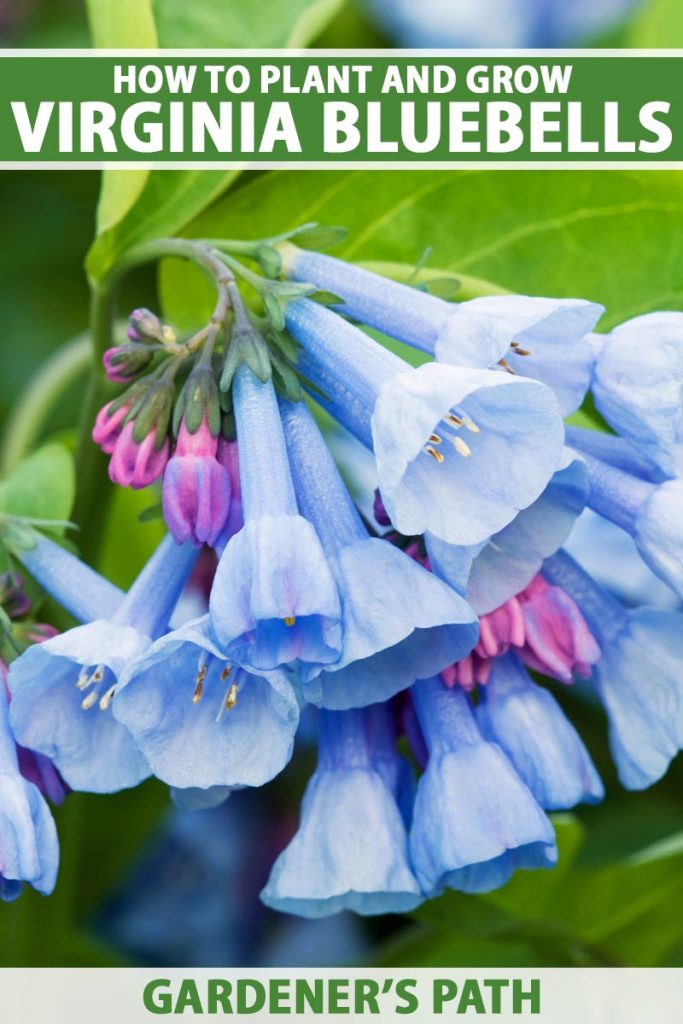
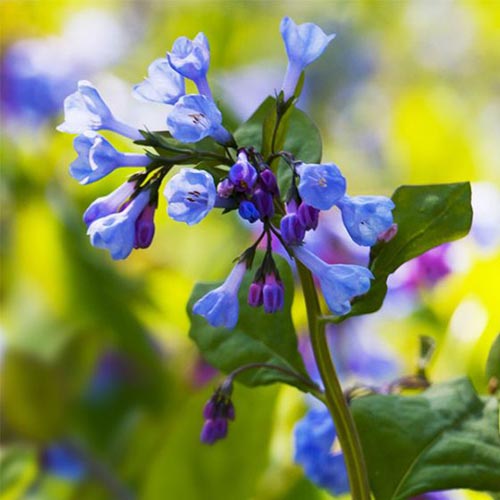
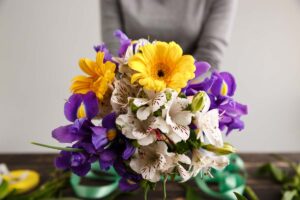

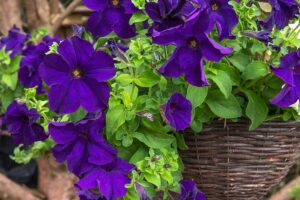
I appreciate all the info. and also have the habit of falling in love with all plants! I do have a question about adding leaf mulch since eventually it increases the depth of the rhizome in the soil. Thank you
Hello Charlotte, and apologies that this comment escaped our attention last year. But the answer is still relevant.
You should apply the mulch around, not on top of, the rhizomes.
Thanks for reading!
Can Virginia bluebell root be planted in a pot while waiting for spring in Minnesota
Hello Kathleen!
I wouldn’t necessarily plant it in a pot indoors, since it needs a period of cold to promote the blooms. Even in frigid Minnesota, which is USDA Hardiness Zone 4, it will grow as a perennial outdoors.
You can grow these in pots outdoors.
There are more instructions on the need for chill hours and also ways to grow the bluebells from divisions here.
Good luck and stay warm.